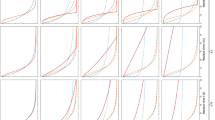Abstract
A theoretical study is made of three organ flow models with heterogeneity of capillary transit times. A new parametrization of Rose and Goresky's Model III facilitates in many cases a reduction to Goresky's Model II, accomplished by a special time shift. The shift parameter\(\tau _{c_z } = \tau _{c_m } - t_{APP} /b\) defined here is critical in this analysis of Model III. A new expression of the series for outflow concentration in Model III is given and proves useful in examining the model as an operator and in relating it to Models I and II. A result on parameter optimization is given: if\(\tau _{c_z } \geqslant 0\) then Model III cannot fit better than Model II. This is applied to some data from Rose and Goresky [Circulation Res. 39, 541–544 (1976)] and raises a new question about their model. A heart model of Levin and Bassingthwaighte based on regional flow measurement is shown to be a discretized generalization of Model II.
Similar content being viewed by others
Literature
Aroesty, J. and J. F. Gross. 1970. “Convention and Diffusion in the Microcirculation.”Mic. Res. 2, 247–267.
Bassingthwaighte, J. B. 1966. “Plasma Indicator Dispersion in Arteries of the Human Leg.”Circulation Res. 19, 332–346.
— 1974. “A Concurrent Flow Model for Extraction during Transcapillary Passage.”Circulation Res. 35, 483–503.
—, T. J. Knopp and J. B. Hazelrig. 1970. “A Concurrent Flow Model for Capillary-Tissue Exchanges.” InCapillary Permeability, C. Crone and N. A. Lassen (Eds.) Copenhagen, Munksgaard.
Bateman, J. M. and T. R. Harris. 1984. “Capillary Operators.”Bull. math. Biol. 46, 247–268.
Collins, J., K. A. Overholser, J. M. Bateman and T. R. Harris. 1983. “Effects of Blood Flow Heterogeneity on Coronary Capillary Permeability-Surface Area Estimation.”Mic. Res. 25, 229.
Goresky, C. A., W. H. Ziegler and G. G. Bach. 1970. “Capillary Exchange Modelling: Barrier-limited and Flow-limited Distribution.”Circulation Res. 27, 738.
Levin, M. and J. B. Bassingthwaighte. 1982. “Estimation of Myocardial Capillary and Cellular Permeability-Surface Area Products with Heterogeneity of Regional Flows.” Manuscript.
—, J. Kuikka and J. B. Bassingthwaighte. 1980. “Sensitivity Analysis for a Coronary Circulation Model.”Med. Prog. Technol. 7, 119–124.
Rose, C. P. and C. A. Goresky. 1976. “Vasomotor Control of Capillary Transit Time Heterogeneity in the Canine Coronary Circulation.”Circulation Res. 39, 541–544.
—— and G. G. Bach. 1977. “Capillary and Sarcolemmal Barriers in the Heart. An Exploration of Labeled Water Permeability.Circulation Res. 41, 515–532.
Rowlett, R. D. and T. R. Harris. 1976. “A Comparative Study of Organ Models and Numerical Techniques for the Evaluation of Capillary Permeability from Multiple-indicator Data.”Mathl Biosci. 29, 273–298.
Author information
Authors and Affiliations
Additional information
This work supported in part by PHS Grant Nos. HL-19153 (SCOR for Pulmonary Vascular Disease) and HL-19370 at Vanderbilt University.
Rights and permissions
About this article
Cite this article
Bateman, J.M. Heterogeneous organ models. Bltn Mathcal Biology 48, 525–543 (1986). https://doi.org/10.1007/BF02462322
Received:
Revised:
Issue Date:
DOI: https://doi.org/10.1007/BF02462322




